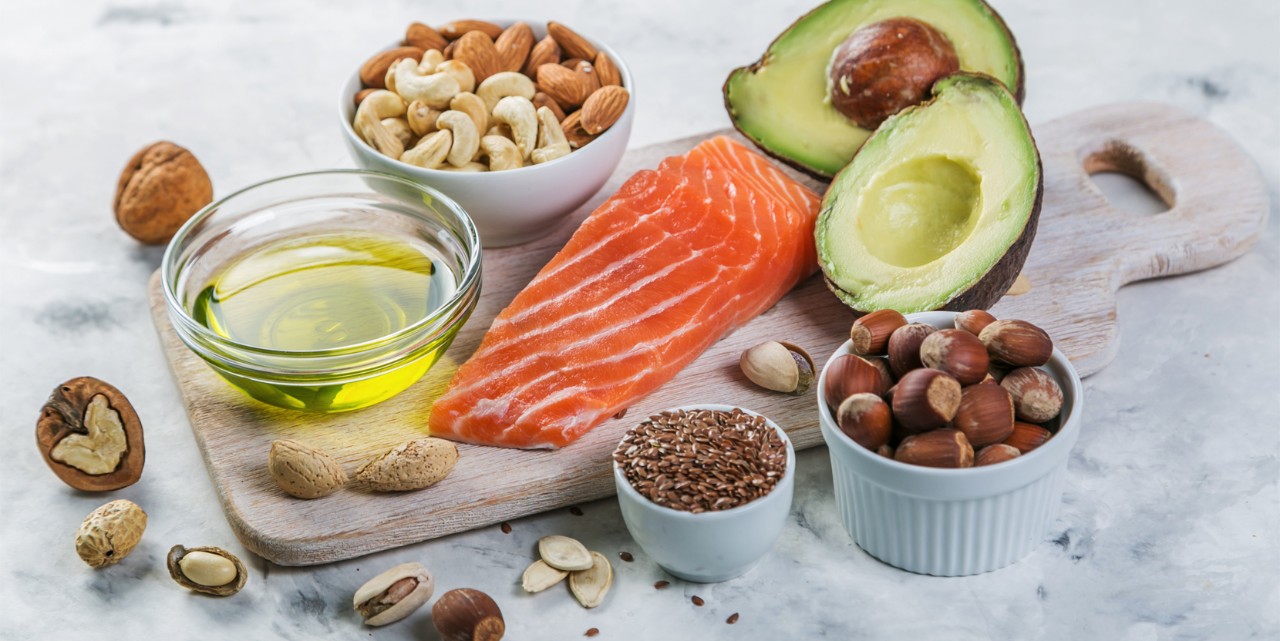Which fats are healthy?
Fat was long thought to be unhealthy. Today we know better. A distinction is made between trans fats, saturated and unsaturated fatty acids.

Healthy or unhealthy fats?
There’s no getting around the fact that our bodies need fat. We need this essential nutrient to absorb the vitamins A, D, E and K, for example. The Swiss Society for Nutrition (SGE) recommends that we get around 20 to 35% of our daily energy intake in the form of fat. But not all fats are the same. Our diet should include a mix of saturated, unsaturated and polyunsaturated fatty acids – ideally at a ratio of one-third each. Anyone alternating different oils in hot and cold meals is sure to get a balanced mix of healthy fats. Trans fats are the only ones to watch out for because they have a negative impact on our health.
Trans fats, saturated or unsaturated fatty acids?
- Monounsaturated fatty acids help the body utilise the fat-soluble vitamins A, D, E and K. These fatty acids are light and easily digestible.
Found in: avocados, olive oil, rapeseed oil, peanuts, almonds, pistachios
Recommended amount: 10 to 15% of our daily energy intake - Polyunsaturated fatty acids are mainly divided into omega-3 and omega-6 fatty acids. These are essential for life and must therefore be eaten in sufficient quantities. Omega-6 is important for growth, wound healing and defence against infection. However, it is also dangerous to eat too much of these seemingly health fats, because the substances produced from omega-6 fatty acids can cause inflammation. It is crucial that omega-3 and omega-6 fatty acids are consumed in a balanced ratio of 1:4 (a typical meal today corresponds to a ratio of 1:10 to 1:20). It’s easy to implement this balance in your everyday life if you take a closer look at the ratio of omega-3 to omega-6 in food. For example, it’s 1:8 in virgin olive oil compared to 1:120 in sunflower oil.
Occurrence:
fatty fish such as salmon, microalgae, rapeseed oil, linseed oil, walnuts, leafy vegetables Omega-3 is found in:
sunflower oil, safflower oil, corn oil, meat, butter, milk and dairy products
Recommended amount:
Omega-3 0,5 to 2% of our daily energy intake
6 to 9% of our daily energy intake - The body can produce saturated fatty acids itself and doesn’t need any extra from external sources. They are primarily found in animal-based foods.
Found in: butter, milk, cheese, meat and charcuterie products, palm oil and coconut oil
Recommended amount: max. 10% of our daily energy intake - Trans fats are modified unsaturated fatty acids. They are mainly produced by the industrial hardening of fats and by strong heating (e.g. deep-frying), but also occur naturally in the first stomach of ruminants. Trans fats of animal origin are found in the fat of meat and dairy products. Industrial trans fats have a negative impact on our blood lipids and increase the risk of cardiovascular disease. They do not have to be officially labelled on food in Switzerland and the EU. The presence of industrial trans fats is indicated by the statements “vegetable fat, partially hardened” and “unsaturated fatty acids, contains hydrogenated fats”.
Found in: fried food, chips, muesli bars, baked goods, ready meals (industrial trans fats); meat, milk and dairy products (natural trans fats)
Recommended amount: As little as possible (maximum 1% of daily energy intake)
Animal or vegetable?
Healthy fats come largely from plant-based sources. If you want to do something good for yourself, it’s best to choose unprocessed foods such as nuts, seeds, avocados and olives. Since animal fats mainly contain saturated fatty acids, these should be eaten in moderation.
Fats or carbohydrates?
To get a balanced diet, the body needs all three essential nutrients: healthy fats, carbohydrates and protein. However, fat provides twice as much energy as the other nutrients. Nevertheless, it is said to have more positive health effects than carbohydrates. A large-scale international study (“Pure”, 2017, Download) indicates that fat provides twice as much energy as the other nutrients, but is said to have more positive health effects than carbohydrates. Researchers found that the mortality risk increases by 28% if the total energy requirement is supplied by at least 68% carbohydrates. However, if a person consumes 35 percent of their total energy requirement from fat, their mortality risk is reduced by 23 percent compared to a person with a low fat consumption. Surprisingly, the type of fat does not matter for this positive effect. Nutritionist Paolo Colombani also sticks up for healthy fats and says that it is carbohydrates that lead to the increase in cholesterol.
Butter or margarine?
For a long time, margarine was considered a healthy alternative to unhealthy butter, because the vegetable fats in margarine seemed healthier than the animal fats in butter. This was followed by an about-turn, with margarine being considered unhealthy because it contained a high proportion of trans fatty acids due to the partial hardening of vegetable oils. In the meantime, food technology has made such great progress that margarine is now highly recommended.
Cold-pressed or refined?
Cold-pressed oil contains polyunsaturated fatty acids, vitamins and has a natural, rather strong aroma. When an oil is hot-pressed, it needs to be cleaned of undesirable substances (refining). This process destroys vitamins and the unsaturated fatty acids contained in natural oil. It also has a more neutral taste. The difference between the two oil products lies mainly in their use: Cold-pressed oil loses its nutrients at high temperatures, and harmful trans fats can also be produced. It is therefore better for cold or luke warm meals. Refined oil, on the other hand, is heat-resistant and therefore ideal for cooking and frying.


